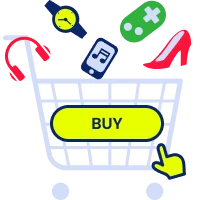28 July 2025
1084
15 min
0.00
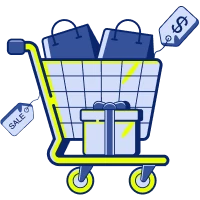
How to Increase Ecommerce Sales: 10 Actionable Strategies
Content
Some estimates put the number of ecommerce websites at 13 million, and that’s one of the most conservative figures. What this means for your business is that with the barrier to entry in the ecommerce niche being low, the competition is on the rise.
That’s why one of main goals for ecommerce business is to constantly be working on improving brand awareness, getting more traffic to your website or social media page, and ultimately, increasing ecommerce sales.
And this guide will walk you through the ten most impactful strategies.
What Impacts Ecommerce Sales the Most?
There are multiple factors that lead up to a purchase in any industry. To increase ecommerce sales, you’ll need to understand how the decision-making process works for your typical customer, find bottlenecks in that process, and optimize them.
If you want to find out what impacts customer behavior and leads to sales on your website, explore customer journey mapping. See how they enter your website, how they browse it, at which point they convert, and what may be a blocking point for conversions.
You’ll typically find that factors influencing sales belong to one of these areas:
- Clear brand messaging
- Product quality and pricing
- User experience
- Customer service
- Ecommerce marketing strategy
In this guide, we’ll cover how you can improve UX, CS, product pricing, and the general marketing strategy to increase eCommerce sales.
How to Increase Ecommerce Sales: 10 Strategies
The exact steps you’ll need to take to increase ecommerce sales depend on your business: what are the bottlenecks you need to improve, and what are the growth opportunities? You’ll likely use several of these ten strategies for growing your sales revenue.
1. Run Smart Competitor Analysis
Before you start implementing any changes on your website, analyze your competitors to understand what strategies they use and what can work for you.
1. Compile a list of competitors.
Don’t add large marketplaces like Amazon or Walmart to the list. These are a bit too big for a small or medium-sized ecommerce store to compete with, and analyzing their strategies might not be applicable in your case.
Add around ten competitors that sell similar products in your area and take a close look at the key aspects of their business.
2. Study products and pricing.
Look at the types of products they’re selling, what the pricing is, and how often they announce deals or sales. This process might differ depending on whether you and your competitors are manufacturers or resellers.
In case of reselling, you can consider adding best-selling products to your catalogue. In case of manufacturing, you might either invest in R&D to match their unique products or improve brand messaging to highlight your products’ unique characteristics.
3. Look at the customer experience your competitors provide.
Compare your delivery options, return policies, and reviews. Pay attention to how they handle providing support across different channels.
4. Analyze competitors’ marketing channels.
Use ecommerce analytics to look through the competitor’s special media profiles to assess what content they post and what influencers they work with to create user-generated content (UGC). Subscribe to their newsletter, and look at their profiles on marketplaces like Amazon. You can also motivate your own team to contribute creative campaign ideas by recognizing their efforts through an employee rewards software, which helps maintain enthusiasm and accountability across marketing initiatives.
5. Analyze SEO.
Since the absolute majority of ecommerce businesses have a website, run an SEO competitor analysis using SE Ranking. Investigate which pages and keywords drive the majority of organic traffic to find gaps in your keyword optimization and general SEO strategy.
The insights you draw from competitor analysis can help you inform your ecommerce growth strategies. Confirm that a strategy or a tactic is working well for the competitor before adopting it. You can also collaborate with an SEO partner to turn these insights into tailored, actionable strategies.
2. Use Pricing Tactics
Pricing is among the first things customers pay attention to. Considering that people tend to do research online before making a purchase, especially with more expensive items, pricing your products too high can be a major turn-off.
Use competitive pricing strategies to avoid this. There are several ways to do this.
- Based on your previous research on the pricing of the same or similar products at your competitors, set it at the same price as the market average.
- Price them lower if you can manage reduced margins.
- Consider underpricing the most popular product in your niche and using upselling tactics to drive up the average order value (AOV).
- Price your products above the market if they’re better, and you can communicate that.
- Introduce a price-matching offer.
- Implement competitive pricing dynamically with a pricing management tool to adjust pricing seasonally or in response to price changes from your competitors.
- Put together bundles of related products and sell them at a lower price.
For instance, if you run an arts and crafts store, you can create beginner bundles.
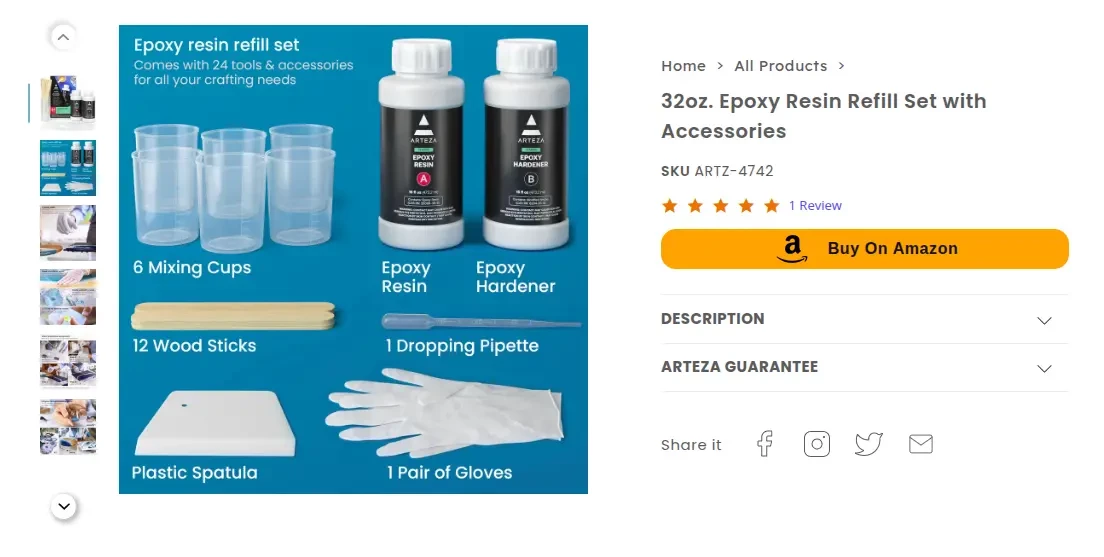
This can help you improve engagement with customers who aren’t really sure what products they need, build a new stream of ecommerce sales, and reduce inventory.
3. Improve User Experience
46% of customers leave brands after just two bad experiences, and the bar is rather high. Everything from poor navigation structure to a lack of key information on a product page can be considered a bad experience in the eyes of a customer.
For instance, loading time measurably reduces conversions and increases bounce rate within a few seconds of delay. Visual stability of a page also plays a major role. Seeing something like the poorly displayed image below can drive visitors away.

To improve user experience on your website, focus on these areas:
- Improve Core Web Values like page loading speed and visual stability.
- Create intuitive navigation in website design.
- Write clear and informative copy for product pages.
- Improve mobile optimization.
- Keep your SSL certificate updated.
4. Implement Performance Marketing
An optimal way to expand the portfolio of marketing channels is to explore performance marketing. This marketing approach involves creating a partnership deal and paying your partner only after a sale happens. There are multiple channels of finding performance marketing partners:
- Affiliate marketers.
- Social media influencers.
- Native advertising deals.
You can proactively reach out to websites that have articles listing the best products in a niche. For instance, if you’re selling gardening supplies, google one of your products and add “best” to the query, like “best lawnmowers.” Many of the articles, like the ones below, can feature products from your ecommerce website.
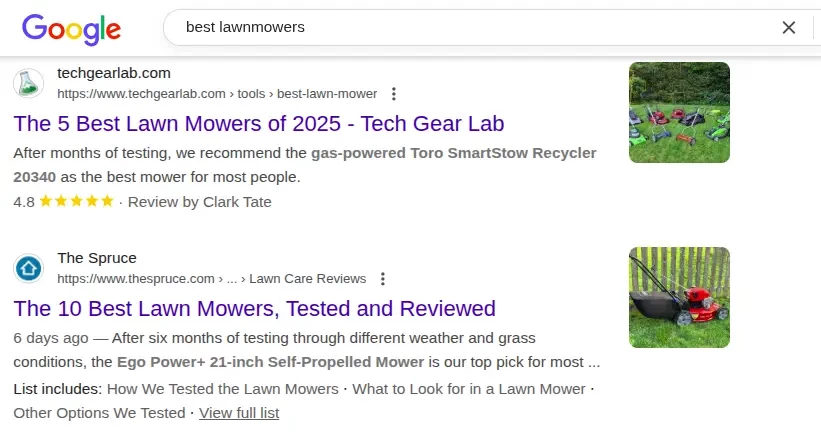
Compile a list of articles like these, reach out to website owners, and offer a partnership.
The way performance marketing works is that a website owner or an influencer promotes your products and receives a commission once someone makes a purchase from the link. Typically, the commission is viable within 30-60 days of visiting an affiliate link and can range between 15-30% of the sale amount.
You might break even on the sales due to a high commission, but you need to make up for it by retaining the customers who come from performance marketing. It’s even better if your customer lifetime value is high, and a small loss on the first purchase won’t hurt the long-term profit.
5. Provide AI-Driven Product Recommendations
Product recommendations can help you increase the average check and overall sales by upselling relevant items to customers while they shop at your ecommerce store. The catch is in making personalized product suggestions based on the search and purchase history of your customer; otherwise, users will ignore them.
You can map out your product, create a list of products that are frequently purchased together, and use that as a basis for recommendations. A better option is to use machine learning systems to map out related products automatically, like Yespo does.
CDP can analyze product purchasing patterns and provide suggestions to customers based on the product they are viewing and their demographic and behavioral data.
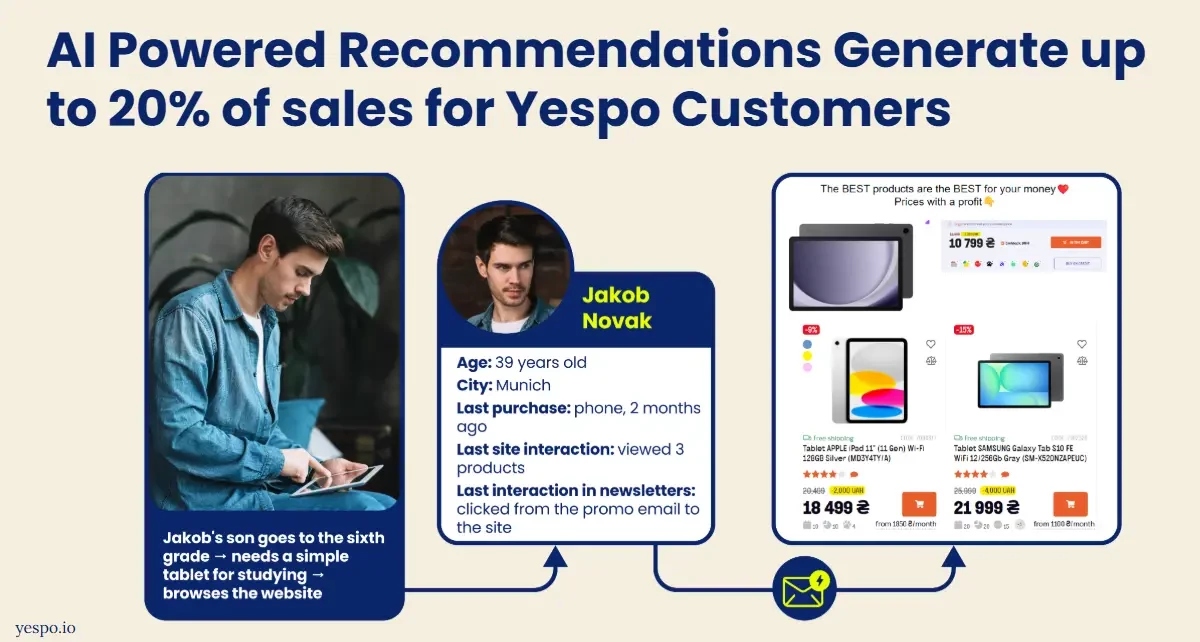
6. Create a Selling Strategy with Instagram Influencers
69% of companies with more than 100 employees are using Instagram influencer marketing to reach their sales goals. That’s likely because 63% of consumers are likely to buy products that influencers they trust recommend.
Collaboration with influencers can take many forms:
- Sponsored posts.
- Sponsored stories.
- Product reviews.
- Collaborative posts.
- Account takeovers.
- Brand ambassador deals.
Forms of payment for this type of marketing can range from a flat fee per post to a percentage of a sale. You can provide discounts or loyalty programs to the subscribers of the influencer you partner with to drive more ecommerce sales.
7. Improve and Personalize Customer Service
47% of customers are willing to pay more for better customer service, Salesforce's 2023 study shows. Improving your support process and its personalization can help you increase customer retention and brand trust.
To build a presence and good CS across all marketing channels, use customer data from an omnichannel marketing platform like Yespo, and introduce comprehensive customer service solutions. To save your CS team’s time and provide valuable information to your customers, consider using an AI chatbot as a support solution.
A chatbot can provide information from your knowledge base and product list to the user or connect them to a human representative for more difficult questions.
8. Use Ecommerce Inventory Data for the Shopping Graph
Google Shopping results like these appear on many ecommerce-related searches and give consumers the option to explore multiple products and ecommerce sites from the search results page.
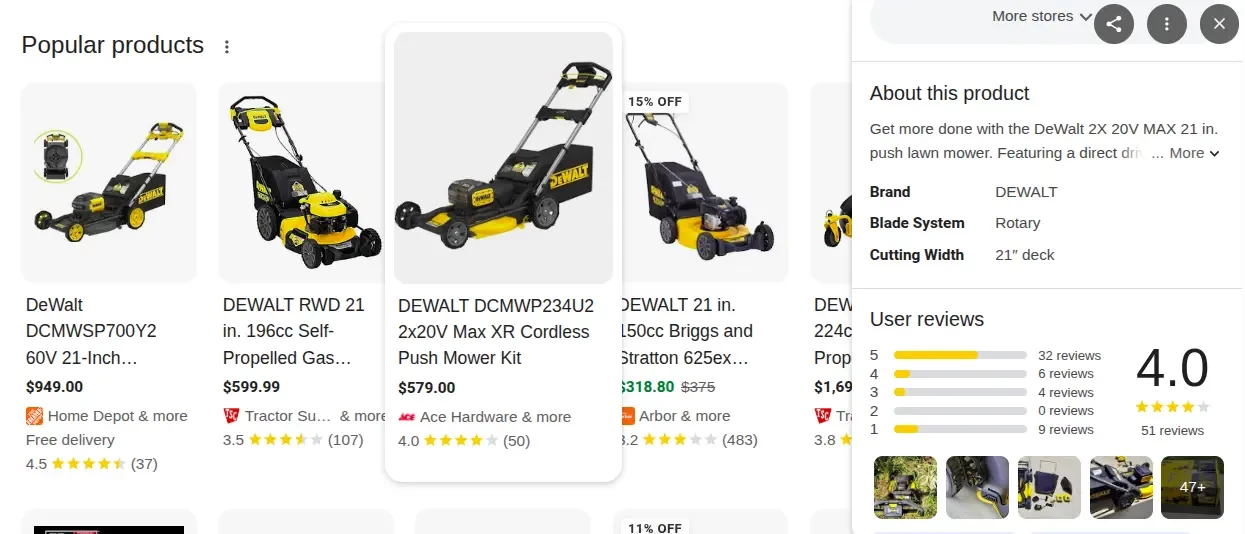
Providing Google with accurate data is crucial for performing well in these types of search results. Use quality images, write keyword-rich product titles, and send updated inventory and pricing information to Google Merchant Center.
You might want to invest in improving how your business deals with inventory management because the faster you update that information on Google Merchant Center, the better.
9. Leverage Wise Email Marketing
Email is one of the most productive marketing channels in ecommerce. It allows you to work with people who have either made a purchase with you before or subscribed to your newsletter. They’re more likely to engage with your marketing content as they’re interested in your brand.
To make your email marketing campaigns more effective, do demographic and behavioral segmentation of the email list. Send personalized emails to the segmented list to make sure you provide relevant suggestions and drive conversions.
A/B test all elements of the email campaign, from the subject line to the product offer, to find what works for each segment.
One area where email marketing can quickly increase ecommerce sales is cart abandonment recovery. Seven out of ten visitors abandon their carts without completing their purchases. Automated workflows that remind users about items they wanted to buy have a 45% open rate—nearly 2.5 times higher than standard ones
10. Encourage Customer Reviews and Testimonials
Since most consumers trust online reviews and USG as much as recommendations from people they know, amassing reviews plays a crucial role in retail marketing. Reviews on Google, specialized review platforms, and product pages can play a role in building brand trust with consumers.
To incentivize reviews, use the following strategies:
- Send an email campaign asking for a review.
- Ask for reviews after a purchase.
- Use widgets such as NPS to encourage customers to share their purchase experience.
- Consider offering discounts or limited-time offers to users who leave a review.
- Engage with reviews, even negative ones, to show users you care about solving customer issues.
Highlight customer reviews on your website to improve user trust, which directly translates into ecommerce sales.
How to Increase Ecommerce Sales with Yespo
Yespo is an omnichannel customer data platform built to support ecommerce businesses at every stage of the customer journey. With a powerful combination of AI-driven tools, personalized messaging, and seamless integrations, Yespo helps brands increase conversions, average order value, and customer retention with:
- AI-based product recommendations. You can increase cross-sells and upsells by including appropriate product suggestions in all direct channels and on the website. Yespo's recommendation engine generates customized offers based on prior purchases, item features, and real-time user activity.
- Omnichannel communication. Use a single platform to interact with your customers via email, SMS, web push, in-app, Viber, and more. Make sure your messages are consistent across all platforms to boost conversion rates.
- Advanced email marketing. Automate win-back campaigns, product updates, abandoned cart emails, etc. To customize each message to the user’s preferences, employ segmentation, A/B testing, and dynamic content.
- Automated workflows. Create drag-and-drop automated triggered scenarios for any stage of the funnel: onboarding, reactivation, upselling, or feedback collection.
With Yespo, ecommerce businesses can simplify their tech stack, reduce manual work, and focus on delivering high-impact, personalized experiences that drive growth.
Final Thoughts
There isn’t a single recipe on how to boost ecommerce sales. Each business will have to investigate its internal sales processes and do competitor research to find growth opportunities.
Depending on what your ecommerce business lacks, you might invest in improving pricing strategies, user experience, customer support, marketing, or sales funnel optimization. Use a data-backed approach when introducing changes to your strategy and monitor key performance indicators to confirm their effectiveness.

